1857
Spacesuit for Captain Nemo (14 photos)
"Using the device Rukeroylya-Deneyruza invented your compatriot and improved me, you can, without any damage to health can immerse yourself in an environment with very different physiological conditions. This device represents a reservoir of a thick sheet iron into which air is injected under pressure into fifty atmospheres. The reservoir is strengthened on the back seat, as a soldier knapsack. The upper part of the tank contains a kind of bellows that regulate the air pressure, bringing it to normal ... »
Jules Verne "Twenty Thousand Leagues Under the Sea»
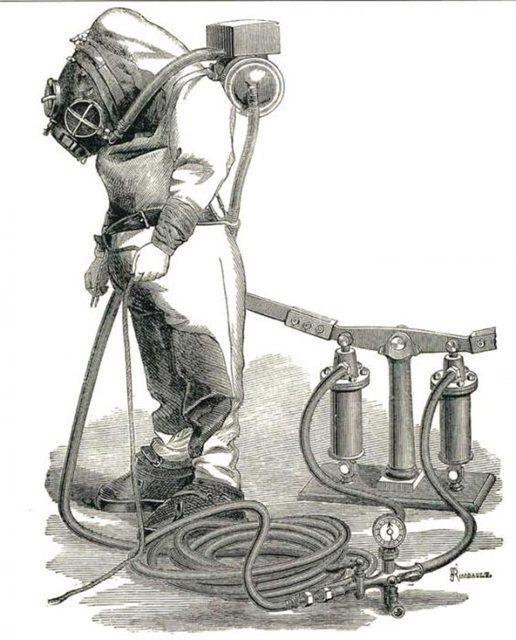
Diving suit Rukeroylya-Deneyruza, 1870
Not sure about Captain Nemo, as well as about his "Nautilus", but a diving suit Rukeroylya-Deneyruza is not an invention of M. Verne. Spacesuit really existed and has been used successfully in Russia.
Professional class divers appeared in Russia in the early XVII century, with the development of the fisheries on the Volga and in the mouth of Yaik (Urals). At the same time, by the way, and there was the term "diver". Divers engaged in maintenance of state-owned and monastery uchugov (underwater pile barriers, which were driven fish). Elder Irinarh of Saviour Priluki Monastery on a bend of the river Vologda in January 1606, said: "I gave the elder Luthor Yakym for diving and nine pots hit the jackpot." And in 1675, Patriarch Joachim complain to Tsar Alexei Mikhailovich: "A de uchyuzhnomu their fishing without wine is impossible to be alone some limits because divers to become stronger uchyuzhnyh faces and water holes without podmoyki and wine into the water and do not climb on their de Astrakhan uchuzhnomu fishing chinittsa motchane and poruha great deal of strife and ". In general, the problem with these hard workers. Where you sit there and slezesh.
History has preserved a lot of "searchlights" diving equipment that would extend the stay of the person at the bottom of the sea. They were, and all sorts of pots and leather bags and wooden casks, worn on the diver's head. But it seems no one except the inventors of these inventions do not apply. Greek sponge divers, divers Astrakhan and Japanese diver-s breath-hold diving. The first diving projectile really will extend the stay of the person under the water became a diving bell, which is a inverted upside down wooden or copper cup. But the hardiest of the divers could not be in more than half due to the bell "stuffiness and thickening the air».
English astronomer Edmond Halley (yes, the same one, Halley, who predicted the return of Halley's comet) built a diving bell, ventilated using barrels of compressed air, sent in from the surface. Oddly enough, the idea was successful and he Halley four workers spent more than 11 hours on a depth of about 9 yards. Ventilation first diving bell with a pump was achieved in 1788 Smeaton and since then many hours of stay of divers under water ceased to be an extraordinary event.

Bell's Comet.
In 1797, the German A. Klingertom was offered the first "clothing for divers", which really can work under water for more than three minutes. It consisted of waterproof fabric on the shoulders of the diver is attached to the edge of the metal hood that covered his head diver. Inside leather two breathing tubes with a control valve for inhalation and exhalation was fixed into a coil spring to the water pressure is not splyusnulo wall. Pump for ventilation costume was not provided because it was assumed diver can breathe in the water alone. In 1798 Klingerta invention has been tested on the Oder River under Vratslavom. Even a slight dive diver breathing difficulties arose, and at a depth of 6 feet to breathe it became impossible due to the fact that the water pressure on the chest of the diver exceeded the strength of respiratory muscles.
Subsequently Klingert perfected his suit, giving it a completely monstrous appearance. To counter the water pressure on the chest diver Klingert turned the machine into a metal breastplate with attach to her leg. Since the leak of this facility was questionable to cuirass was attached pump for pumping water to enter the unit.
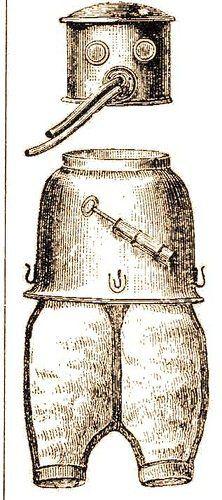
Costume Klingerta
In 1819. emigrated to England German mechanic and gunsmith Augustus Siebe produced the first diving suit made of waterproof material, coupled with a metal helmet. According to the modern classification of this suit was "wet" type, since diving shirt was unsealed. Costume worked on the principle of the diving bell: Since air is supplied diver vessel with a pump in and out from under the bottom edge of the diving shirts are loose to the body. Siebe equipment was successfully tested at work to raise British battleship "Royal George", but bend the diver is not recommended - at inclinations water gets under the shirt.

Diving operations. Engraving 1835
In 1823, the British brothers John and Charles Dean received a patent for a vented suit for firefighters, they in 1828 proposed to use for diving. Breathing air pumped through a hose pump from the shore or a diving boat, the excess air out from under the bottom edge of the helmet. In the Russian outfit Dinov first appeared in 1838 on the Black Sea Fleet in 1848 and has been involved with the rise of the tender "jet", which sank near Novorossiysk Bay at a depth of 20 meters. He commanded the operation of an unknown (not yet known) officer P .S.Nahimov.
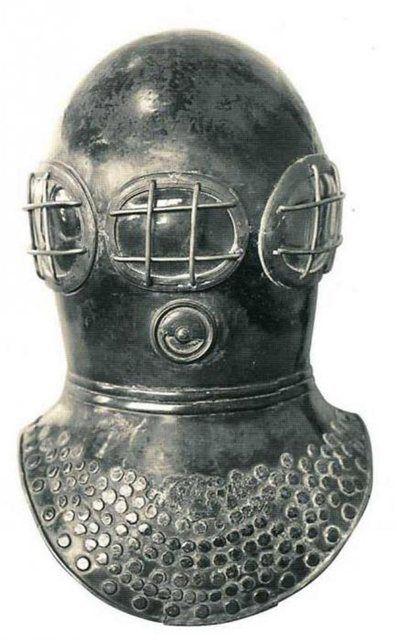
Dean of suit helmet.
Almost simultaneously with the British in 1829-1830 gg. Kronstadt mechanic Gause created a similar suit. The basis of the suit lay still the same principle of the diving bell. The head was placed under a helmet diver in the form of an inverted boiler. The lower edge of the helmet to wear seat curved iron (later leather) bus, which took place between the legs of the diver. Bend in a suit Gause as in a suit Dinov strictly prohibited. Otherwise, the air and the water came out instantly filled the helmet. In 1873, the Kronstadt diver stumbled during the works and took an inclined position, as did not have time to know the signal; he was pulled with no signs of life. Despite the obvious shortcomings suit Gause was used in Russia until the 1870s.
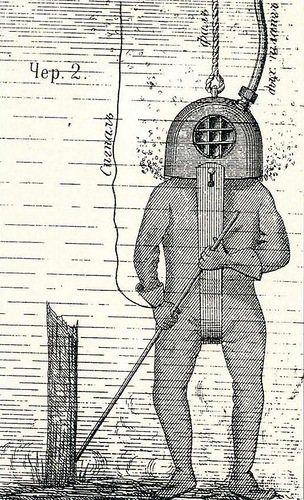
Gause suit. Figure not valid because the diver is depicted without the lead diving boat.
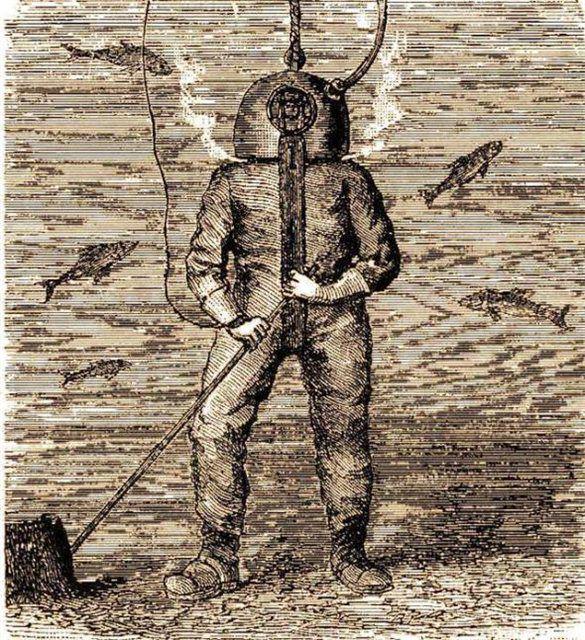
Less clear, but a more reliable picture of the diver in the suit Gause. Illustration from Brockhaus and Efron.
The above Augustus Siebe was not going to stop there. He started the production of advanced diving suits. Now the suit has become an integral and cover the whole body except the hands and lead boats and cargo to ensure adequate stability on the ground. Siebe supplied diving suit etching valve which was on his chest and was driven by the diver. Incidentally, it was the first time named Siebe diving suit "spacesuit" from a combination of the Greek words "boat" and "man." Charles Pasley applied pie thread to connect the bowler hat with shirt front. Thus was born the famous "dvenadtsatiboltovka" company Siebe, Gorman and K °, with minor enhancements used to this day. A patent for an improved diving equipment was issued Augustus Siebe in London in 1855. But in Russia the latest technology of diving got not quite the usual way.
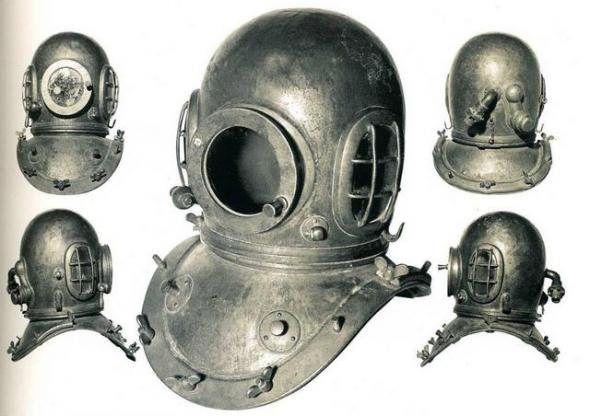
Helmet dvenadtsatiboltovogo equipment Siebe Gorman-release of the 1870s from the funds TSVMM. Photo A.Aristarhova 2006
In 1857, the Russian government has signed a contract with an expert in underwater work Gowen to clear the bottom of the Sevastopol bay. Required to raise or destroy the housing 28 ships sunk during the Crimean War. Together with Gowan arrived in Sevastopol three divers. They undermine the ship's hull powder charges and rises to the surface with a winch.
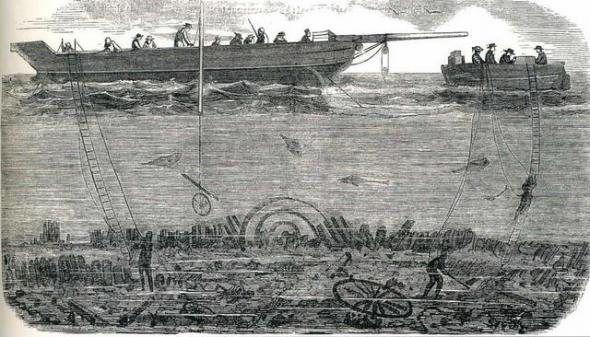
Diving operations in Sevastopol Bay
In the 1857-59 biennium. Englishman Geynke brought in Russian spacesuits nine of his own invention. However, in reality Geynke did not invent, but simply improve the design of equipment Siebe. In Russian patent disputes foreigners few people are worried and in 1861 equipment Geynke was taken into service by the Russian Navy, and at Admiralty Izhora factories were organized its production. In the same 1861 in the states of the crews of warships of the Russian Navy divers were introduced, and diving equipment was regular equipment.
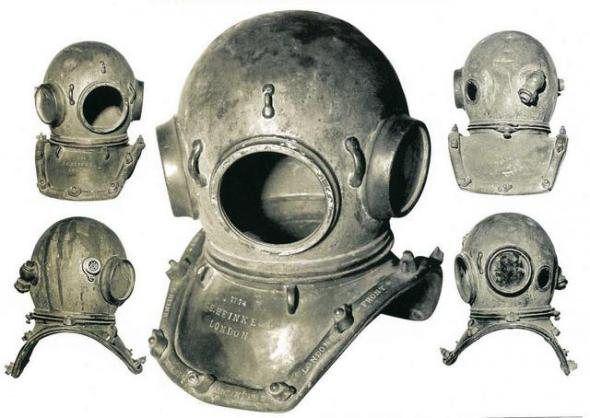
Helmet equipment Geynke of funds TSVMM. Photo A.Aristarhova 2006
Finally, equipment Rukeroylya-Deneyruza sample 1865 celebrated genius Jules Verne. Equipment lieutenant of the French navy Deneyruza and mining engineer Rukeroylya consisted of a rubber shirt and copper with the front of the portholes. For a distinctive appearance mask named «Le Groin» - «pig's snout." The mask was attached to a special shirt collar. Air is supplied from the surface through a hand pump ranets- "aerophore", consisting of a cylinder receiver and ADF air. Diver inhales air through the hose with a mouthpiece and exhale into the water through the petal valve at the same hose. Air supply to allow the diver to breathe knapsack with cross-clamping or a hose. However, not for 9-10 hours Jules Verne, but only about 15 minutes. But this is often enough to lift the diver.

Diving station, equipped with equipment Rukeroylya-Deneyruza. Engraving 1870s. In the foreground - a diver without a mask. Right at the ramp - diver ready to descend.
In an emergency, when required emergency descent diver equipment Rukeroylya-Deneyruza could be used without diving shirts and masks:

Diver with the device Rukeroylya-Deneyruza ready for emergency descent
Disadvantages equipment Rukeroylya-Deneyruza visible to the naked eye: Weighty metal mask hanging diver almost on the eyebrows and protects the head from injuries, small portholes distant from the eye and through them easily see anything, the connection mask shirt with metal clamp is hardly reliable . In addition, divers noticed a lot of resistance to breathing. However, the equipment was awarded the highest prize at the Paris World Exhibition in 1867.
In the Russian outfit Rukeroylya-Deneyruza sample 1865 appeared at the end of the 1860s. and used civilian divers working in the construction supports Foundry Bridge in St. Petersburg. But the fight awkward masks was not under force even the harsh Russian peasant. Fleet rejected gear Rukeroylya-Deneyruza. To its credit, the French should be noted that already in 1872 at an exhibition in St. Petersburg, they presented an improved outfit with a normal metal helmet. The highlight of the equipment has become the method of fixation bowler hat to shirtfront - screwed. Quickly remove the helmet to "clear his head" as a dvenadtsatiboltovkah Siebe impossible (try to quickly turn away three nuts), but increased pressure suit.
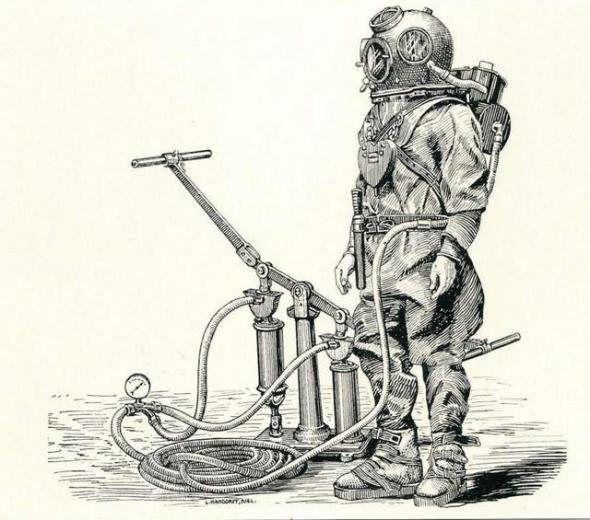
Enhanced suit Rukeroylya-Deneyruza arr. 1872
Equipment Rukeroylya-Deneyruza arr. In 1872 it was decided to adopt the Russian Navy. His production has been established at Admiralty factories and Kronstadt experienced mechanical and diving workshop Kolbasevyh brothers. Revised gear Russian masters it became the prototype of "Three bolt equipment," Welcome to the fleet and in the ports of Russia to this day.
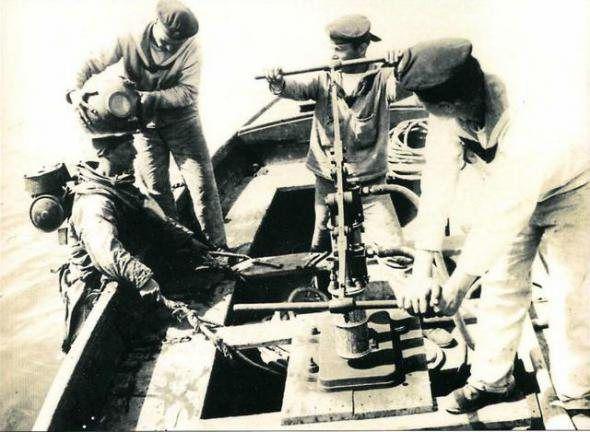
Photography end of the 1890s. Perhaps the first photo Russian divers. Diver in trёhboltovom gear arr. 1872, with the respiratory Deneyruza knapsack on his back. Everything is exactly as described by M. Jules Verne in his novel.
P.S. Captain Nemo was in solidarity with the Russian Navy diving service in his critical attitude to the original version of equipment Rukeroylya-Deneyruza sample 1865 On page 116 (ed. "Truth" 1985) we read: "... to bear on the seabed considerable pressure of the upper layers water, instead of a mask had to put on his head, as in a spacesuit, helmet with two copper tubes - inspiratory and expiratory. " The novel was published in 1870. Two years later, engineers improved the suit, replacing mask helmet. And you say - science fiction!
Jules Verne "Twenty Thousand Leagues Under the Sea»

Diving suit Rukeroylya-Deneyruza, 1870
Not sure about Captain Nemo, as well as about his "Nautilus", but a diving suit Rukeroylya-Deneyruza is not an invention of M. Verne. Spacesuit really existed and has been used successfully in Russia.
Professional class divers appeared in Russia in the early XVII century, with the development of the fisheries on the Volga and in the mouth of Yaik (Urals). At the same time, by the way, and there was the term "diver". Divers engaged in maintenance of state-owned and monastery uchugov (underwater pile barriers, which were driven fish). Elder Irinarh of Saviour Priluki Monastery on a bend of the river Vologda in January 1606, said: "I gave the elder Luthor Yakym for diving and nine pots hit the jackpot." And in 1675, Patriarch Joachim complain to Tsar Alexei Mikhailovich: "A de uchyuzhnomu their fishing without wine is impossible to be alone some limits because divers to become stronger uchyuzhnyh faces and water holes without podmoyki and wine into the water and do not climb on their de Astrakhan uchuzhnomu fishing chinittsa motchane and poruha great deal of strife and ". In general, the problem with these hard workers. Where you sit there and slezesh.
History has preserved a lot of "searchlights" diving equipment that would extend the stay of the person at the bottom of the sea. They were, and all sorts of pots and leather bags and wooden casks, worn on the diver's head. But it seems no one except the inventors of these inventions do not apply. Greek sponge divers, divers Astrakhan and Japanese diver-s breath-hold diving. The first diving projectile really will extend the stay of the person under the water became a diving bell, which is a inverted upside down wooden or copper cup. But the hardiest of the divers could not be in more than half due to the bell "stuffiness and thickening the air».
English astronomer Edmond Halley (yes, the same one, Halley, who predicted the return of Halley's comet) built a diving bell, ventilated using barrels of compressed air, sent in from the surface. Oddly enough, the idea was successful and he Halley four workers spent more than 11 hours on a depth of about 9 yards. Ventilation first diving bell with a pump was achieved in 1788 Smeaton and since then many hours of stay of divers under water ceased to be an extraordinary event.

Bell's Comet.
In 1797, the German A. Klingertom was offered the first "clothing for divers", which really can work under water for more than three minutes. It consisted of waterproof fabric on the shoulders of the diver is attached to the edge of the metal hood that covered his head diver. Inside leather two breathing tubes with a control valve for inhalation and exhalation was fixed into a coil spring to the water pressure is not splyusnulo wall. Pump for ventilation costume was not provided because it was assumed diver can breathe in the water alone. In 1798 Klingerta invention has been tested on the Oder River under Vratslavom. Even a slight dive diver breathing difficulties arose, and at a depth of 6 feet to breathe it became impossible due to the fact that the water pressure on the chest of the diver exceeded the strength of respiratory muscles.
Subsequently Klingert perfected his suit, giving it a completely monstrous appearance. To counter the water pressure on the chest diver Klingert turned the machine into a metal breastplate with attach to her leg. Since the leak of this facility was questionable to cuirass was attached pump for pumping water to enter the unit.

Costume Klingerta
In 1819. emigrated to England German mechanic and gunsmith Augustus Siebe produced the first diving suit made of waterproof material, coupled with a metal helmet. According to the modern classification of this suit was "wet" type, since diving shirt was unsealed. Costume worked on the principle of the diving bell: Since air is supplied diver vessel with a pump in and out from under the bottom edge of the diving shirts are loose to the body. Siebe equipment was successfully tested at work to raise British battleship "Royal George", but bend the diver is not recommended - at inclinations water gets under the shirt.

Diving operations. Engraving 1835
In 1823, the British brothers John and Charles Dean received a patent for a vented suit for firefighters, they in 1828 proposed to use for diving. Breathing air pumped through a hose pump from the shore or a diving boat, the excess air out from under the bottom edge of the helmet. In the Russian outfit Dinov first appeared in 1838 on the Black Sea Fleet in 1848 and has been involved with the rise of the tender "jet", which sank near Novorossiysk Bay at a depth of 20 meters. He commanded the operation of an unknown (not yet known) officer P .S.Nahimov.

Dean of suit helmet.
Almost simultaneously with the British in 1829-1830 gg. Kronstadt mechanic Gause created a similar suit. The basis of the suit lay still the same principle of the diving bell. The head was placed under a helmet diver in the form of an inverted boiler. The lower edge of the helmet to wear seat curved iron (later leather) bus, which took place between the legs of the diver. Bend in a suit Gause as in a suit Dinov strictly prohibited. Otherwise, the air and the water came out instantly filled the helmet. In 1873, the Kronstadt diver stumbled during the works and took an inclined position, as did not have time to know the signal; he was pulled with no signs of life. Despite the obvious shortcomings suit Gause was used in Russia until the 1870s.

Gause suit. Figure not valid because the diver is depicted without the lead diving boat.

Less clear, but a more reliable picture of the diver in the suit Gause. Illustration from Brockhaus and Efron.
The above Augustus Siebe was not going to stop there. He started the production of advanced diving suits. Now the suit has become an integral and cover the whole body except the hands and lead boats and cargo to ensure adequate stability on the ground. Siebe supplied diving suit etching valve which was on his chest and was driven by the diver. Incidentally, it was the first time named Siebe diving suit "spacesuit" from a combination of the Greek words "boat" and "man." Charles Pasley applied pie thread to connect the bowler hat with shirt front. Thus was born the famous "dvenadtsatiboltovka" company Siebe, Gorman and K °, with minor enhancements used to this day. A patent for an improved diving equipment was issued Augustus Siebe in London in 1855. But in Russia the latest technology of diving got not quite the usual way.

Helmet dvenadtsatiboltovogo equipment Siebe Gorman-release of the 1870s from the funds TSVMM. Photo A.Aristarhova 2006
In 1857, the Russian government has signed a contract with an expert in underwater work Gowen to clear the bottom of the Sevastopol bay. Required to raise or destroy the housing 28 ships sunk during the Crimean War. Together with Gowan arrived in Sevastopol three divers. They undermine the ship's hull powder charges and rises to the surface with a winch.

Diving operations in Sevastopol Bay
In the 1857-59 biennium. Englishman Geynke brought in Russian spacesuits nine of his own invention. However, in reality Geynke did not invent, but simply improve the design of equipment Siebe. In Russian patent disputes foreigners few people are worried and in 1861 equipment Geynke was taken into service by the Russian Navy, and at Admiralty Izhora factories were organized its production. In the same 1861 in the states of the crews of warships of the Russian Navy divers were introduced, and diving equipment was regular equipment.

Helmet equipment Geynke of funds TSVMM. Photo A.Aristarhova 2006
Finally, equipment Rukeroylya-Deneyruza sample 1865 celebrated genius Jules Verne. Equipment lieutenant of the French navy Deneyruza and mining engineer Rukeroylya consisted of a rubber shirt and copper with the front of the portholes. For a distinctive appearance mask named «Le Groin» - «pig's snout." The mask was attached to a special shirt collar. Air is supplied from the surface through a hand pump ranets- "aerophore", consisting of a cylinder receiver and ADF air. Diver inhales air through the hose with a mouthpiece and exhale into the water through the petal valve at the same hose. Air supply to allow the diver to breathe knapsack with cross-clamping or a hose. However, not for 9-10 hours Jules Verne, but only about 15 minutes. But this is often enough to lift the diver.

Diving station, equipped with equipment Rukeroylya-Deneyruza. Engraving 1870s. In the foreground - a diver without a mask. Right at the ramp - diver ready to descend.
In an emergency, when required emergency descent diver equipment Rukeroylya-Deneyruza could be used without diving shirts and masks:

Diver with the device Rukeroylya-Deneyruza ready for emergency descent
Disadvantages equipment Rukeroylya-Deneyruza visible to the naked eye: Weighty metal mask hanging diver almost on the eyebrows and protects the head from injuries, small portholes distant from the eye and through them easily see anything, the connection mask shirt with metal clamp is hardly reliable . In addition, divers noticed a lot of resistance to breathing. However, the equipment was awarded the highest prize at the Paris World Exhibition in 1867.
In the Russian outfit Rukeroylya-Deneyruza sample 1865 appeared at the end of the 1860s. and used civilian divers working in the construction supports Foundry Bridge in St. Petersburg. But the fight awkward masks was not under force even the harsh Russian peasant. Fleet rejected gear Rukeroylya-Deneyruza. To its credit, the French should be noted that already in 1872 at an exhibition in St. Petersburg, they presented an improved outfit with a normal metal helmet. The highlight of the equipment has become the method of fixation bowler hat to shirtfront - screwed. Quickly remove the helmet to "clear his head" as a dvenadtsatiboltovkah Siebe impossible (try to quickly turn away three nuts), but increased pressure suit.

Enhanced suit Rukeroylya-Deneyruza arr. 1872
Equipment Rukeroylya-Deneyruza arr. In 1872 it was decided to adopt the Russian Navy. His production has been established at Admiralty factories and Kronstadt experienced mechanical and diving workshop Kolbasevyh brothers. Revised gear Russian masters it became the prototype of "Three bolt equipment," Welcome to the fleet and in the ports of Russia to this day.

Photography end of the 1890s. Perhaps the first photo Russian divers. Diver in trёhboltovom gear arr. 1872, with the respiratory Deneyruza knapsack on his back. Everything is exactly as described by M. Jules Verne in his novel.
P.S. Captain Nemo was in solidarity with the Russian Navy diving service in his critical attitude to the original version of equipment Rukeroylya-Deneyruza sample 1865 On page 116 (ed. "Truth" 1985) we read: "... to bear on the seabed considerable pressure of the upper layers water, instead of a mask had to put on his head, as in a spacesuit, helmet with two copper tubes - inspiratory and expiratory. " The novel was published in 1870. Two years later, engineers improved the suit, replacing mask helmet. And you say - science fiction!









